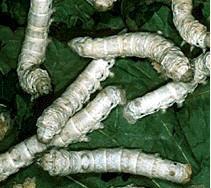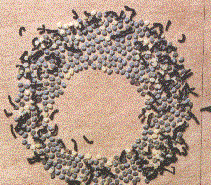

Newborn Caterpillars
Once you have located a source of leaves, and have a container ready, take your eggs out of the refrigerator. They will hatch in 7-20 days, depending on how far developed they were when they were put into the refrigerator. Placing the eggs in direct sunlight seems to speed up the process. Once you can see a dark ring and clear center in the egg, it is almost ready to hatch. They usually hatch at dawn. Have a few leaves on hand since they must eat within a day of hatching. Newborn silkworms will barely nibble at the leaf. It will dry out long before they could possibly eat it up. Change leaves at least three times a day at this stage, so they will grow quickly. If you have access to a low-power microscope (about 30x), let the kids look at a tiny caterpillar. Instead of a tiny black string, they have incredible detail.

The Japanese call this stage "Kego", which means "hairy baby". If you examine the eggshell under a microscope, you can see the pores that let air inside while the caterpillar is developing. The edges of the hole where the caterpillar emerged are black.
Twice a day (three times a day if you have no lid), give the worms fresh leaves. Newborn silkworms look like small black strings this size __ . They are initially too weak to crawl from the old leaf to the new one. Either place the new leaf directly on top of the old leaf, or carefully hand-pick all of the silkworms onto the new leaf. Throw out the old, dried leaf. Put the new leaf with silkworms into the container and replace the lid. If any newborn worms are on the paper with the eggs, gently move them onto a leaf (or place a leaf directly on top of the paper).
After five days, the worms will have the strength to crawl from the old leaves to new ones by themselves, so you won't have to hand-pick them. Then you can just place new leaves in the container. Every two days, empty the container to prevent mold from forming. You'll need to increase the number of leaves as they get older. Caterpillar poop looks like a small black speck when they are little, and like miniature black corn cobs when larger. Make sure leaves do not have dew or water on the surface when feeding newborn silkworms, since they will drown in any small surface film of water.
To continue to the next stage in development, click on older caterpillars.